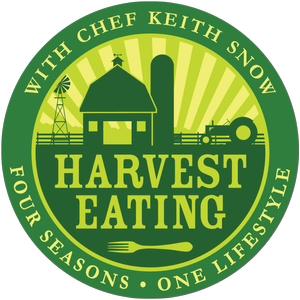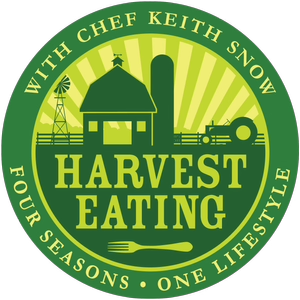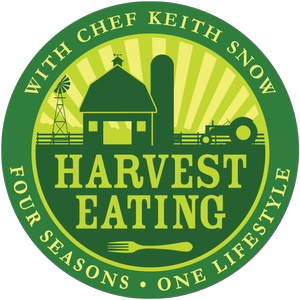
The Harvest Eating Podcast
Keith Snow
All episodes
Best episodes
Top 10 The Harvest Eating Podcast Episodes
Goodpods has curated a list of the 10 best The Harvest Eating Podcast episodes, ranked by the number of listens and likes each episode have garnered from our listeners. If you are listening to The Harvest Eating Podcast for the first time, there's no better place to start than with one of these standout episodes. If you are a fan of the show, vote for your favorite The Harvest Eating Podcast episode by adding your comments to the episode page.

520-Proper Thanksgiving Turkey Is Moist -Not Dry!
The Harvest Eating Podcast
11/21/23 • 48 min
Learn skills to turn basic foods into delicious meals all year long. The Food Storage Feast Online Course pays for itself with a bounty of amazing meals, it’s the education you can eat!
Food Storage Feast Endorsement:
“Food Storage Feast is one of the most important recommendations I can make for your preparedness. Chef Keith has changed my entire perspective on how to really enjoy living off food storage.”
-Joel Skoussen, Author Strategic Relocation, Publisher World Affairs Brief
HARVEST EATING SPICE BLENDS ARE NOW SHIPPINGWe’re excited to share the news that the Harvest Eating spice line is back! The supply chain issues have eased, and packaging is readily available in the quantities we need.
Initially, we will have the following varieties available:
- Grilled Chicken
- Steakhouse Blend
- Carolina BBQ
- Northern Italian
Check out our spice master pack containing 6 cans of our best-selling spices, perfect for Christmas gift giving, save $6 dollars and get free shipping.
Montana Steak, poultry seasoning, and a breakfast sausage blend will also come later this year. Our wholesale prices have increased substantially but we have kept prices the same as before.
WHAT IS ON THE MENU:- one-pot spaghetti
- croque monsieur
- soft boiled eggs
- leek & potato soup
Cocoa prices are hovering around 45-year highs as futures trade over $4,000 per metric ton.
TODAY’S MAIN TOPIC:Proper Thanksgiving Turkey
Making a great turkey is not complicated, but it does require shelving some olf-wives tales and a few basic steps and tools. I always saw my mom basting a turkey, with a flimsy baster that once squired hot juices all over her hand. I don’t recommend basting a turkey, purely a wase of time as it lets heat out, extends cooking times, and causes uneven cooking as the oven has to scramble to come back to temperature. Rubbing the brd with a little olive oil can help aid the browning process but I have achieved great results without doing that either as the skin has enough fat in it to crisp up nicely.
Here are some steps to cooking the perfect moist turkey:
- Allow the bird some time to warm up, and remove from the fridge at 7 am the day of Thanksgiving..!
- Do not overcook the bird, cook at 350 degrees until the thigh reaches 165. Waiting for a pop-up timer ensures dry breasts, do not wait for that timer....watch your probe thermometer instead.
- Do not baste the turkey, just rotate it once after about 1.5 hours
- Be sure to add some liquid to the roasting dish, I use water and white wine, about a cup of each, this helps keep the bird from sticking to the pan and also helps give some great flavor to the gravy later on
When my bird reaches temp, I remove it, from the oven and the roaster, I place it on a sheet tray then cover it with foil and towels to keep it warm before I carve it. I then place the roasting dish on the stove and scrape up any bits and stuff on the bottom, all that stuff goes into my gravy pot.
HOMESTEAD TSUNAMI:Support local farms, especially if they have proteins. I recently bought a bunch of grass-fed and finished beef, pork, and lamb from a local supplier.
ECONOMIC NEWS:
Treasury has to pay back 7.6 trillion to treasury bind holders in the next year, but where are they going to get the money to pay these bondholders? In the next two years, nearly half the national debt will mature...oh GOSH!
PRODUCT RECOMMENDATION:
Altra running shoes-highly recommended!
CLOSING THOUGHTS:Visit local farms and support them!
RESOURCES FOR THIS EPISODE:
https://markets.businessinsider.com/news/commodities/cocoa-prices-futures-high-chocolate-nino-shortages-harvest-commodity-scarcity-2023-11
https://markets.businessinsider.com/news/bonds/us-debt-maturing-bond-yields-treasury-bills-federal-reserve-qt-2023-9
LINKS TO CHECK OUT:
224-Greek Spiced Chicken w Mater Sauce
The Harvest Eating Podcast
06/17/14 • 32 min
In this show I discuss a simple chicken dish, could not be easier, but hte flavors are outstanding....Greek Spiced chicken with mater sauce....give it a try..then post your photo at Facebook.com/haveasteating

139-Answers To Your Questions
The Harvest Eating Podcast
04/22/13 • 47 min
In this episode I answer your questions...feel free to call some in too...864-492-1499

134-Local Food Movement Gaining Momentum
The Harvest Eating Podcast
04/10/13 • 44 min
great news for local food....listen to the latest show

105-Basic Beef Chili
The Harvest Eating Podcast
12/07/12 • 25 min
In this special episode recorded from the Mile High city of Denver I introduce a new sponsor My Patriot Supply.com then briefly describe how I like to make simple beef chili. Real, simple, chili only needs a few basic ingredients; meat, onions, chilies, spices and a little time...

Is This The End Of Chemical Agriculture-? Epi- 453
The Harvest Eating Podcast
02/01/22 • 42 min
See full show notes at Keith Snow.com
s This End Of Chemical Agriculture?
Since the mid-19th-century usage of NPK fertilizer has increased by over 800% up to 2019. This has allowed modern AG to produce a massive amount of food that is used for all sorts of products from cereal, non-dairy milk to fuel additives and beyond. The USA exports billions of tons of commodity foods each year to countries all over the globe.
“U.S. agricultural exports in fiscal year (FY) 2022 are projected at $175.5 billion, down $2.0 billion from the August forecast, but still a record if realized. This decrease is driven by reductions in oilseed and oilseed product exports that are partially offset by increases in livestock, poultry, dairy, cotton, and ethanol exports.”
— USDA
All this food production comes at a steep cost to farmers, the environment, and most importantly, this soil! Studies show that foods grown on American soil have steadily declined in nutritive value.
Vitamins, Minerals, and other components of basic foods (fruits, vegetables, grains) are less nutritious than they were decades ago. This is because modern agriculture used methods that destroy soil life, water infiltration, organic matter, photovoltaic capacity, etc.
The use of chemicals such as Glyphosate (Round Up), herbicides, pesticides, and other inputs are very harsh on soil and surrounding watersheds.
These methods only work when farmers can afford these costly inputs, they have been rising each year but in 2022 input costs are astounding. NPK cost is rising so fast it’s becoming untenable for farmers to plant crops, even with subsidies.
“Texas A&M economists found heading into spring planting, fertilizer prices are up 80% compared to 2021, and in some cases, farmers are seeing certain fertilizer prices more than double what they saw last year. But for the report, AFPC was conservative in its estimate, using a 50% increase in fertilizer costs. ”
— Ag Web
My point to this whole episode is many, small to medium-sized farmers will start to reject this whole system and decide to use Regenerative Agriculture instead of being controlled by “the system” and basically forced to continue injuring their land with this modern chemical-laden system.
I hope it happens, it will be painful, but if there is a will, there is a way!

490-Thinking Like a Chef While Cooking At Home
The Harvest Eating Podcast
03/15/23 • 31 min
Today’s show is done at the behest of one of my Telegram subs and is my attempt to let you see how chefs think at work, and at home too. This topic could go in many directions so I hope I did justice to this subject and provided some helpful insight into how I try to process home cooking using my chef background.
Some of the things I did not mention on the show were mise en place (everything in its place) or what we chefs refer to as “being ready” for the “pick up”. I see many people cooking with poor or non-existent mise en place. So if you’re making a pb& j you need the following for your mise en place:
- peanut butter
- bread
- jam, jelly, preserves? what do you like?
- toaster?
- knife
- cutting board
- plate
- napkin
- a glass of milk....haha....just kidding on these last few items.
You get the point though-don’t start cooking until you have gathered everything you need, including equipment and a place to put the prepared food. And, if you don’t want me barking at you clean as you go, do not leave a bunch of containers, etc on the counters and work around them, that pisses me off to no end!
“Mise” can be complicated, let’s examine an easy example; making a poached egg on toast. You’ll need water boiling in a pot, a slice of toast in the toaster, a slotted spoon, a paper towel or kitchen towel, an egg, salt pepper, and in my case, Worcestershire sauce, serving vessel, all ready to go so you can execute this simple dish.
This probably makes sense to you now. These are just a few of the things that go into cooking at home, in my mind.
LINKS TO CHECK OUT:Perma Pastures Website-buy comfrey!

515-Finding, Storing and Cooking With Winter Squash
The Harvest Eating Podcast
10/14/23 • 31 min
Learn skills to turn basic foods into delicious meals all year long. The Food Storage Feast Membership pays for itself with a bounty of amazing meals, it’s the education you can eat!
Food Storage Feast Endorsement:
“Food Storage Feast is one of the most important recommendations I can make for your preparedness. Chef Keith has changed my entire perspective on how to really enjoy living off food storage.”
-Joel Skoussen, Author Strategic Relocation, Publisher World Affairs Brief
HARVEST EATING SPICE BLENDS TO RETURNWe’re excited to share the news that the Harvest Eating spice line is coming back! The supply chain issues have eased, and the ideal packaging is readily available in the quantities we need to make this happen.
Initially, we will have the following varieties available:
- Grilled Chicken-
- Steakhouse Blend
- Carolina BBQ
- Northern Italian
Montana Steak and a breakfast sausage blend will also come later this year. Our prices have increased substantially but we will do our best to make these as affordable as possible. We will announce a pre-order soon and expect to be shipping by the end of October.
WHAT IS ON THE MENU:- pumpkin pie
- butternut squash gratin
Plant-based dairy category sees huge growth.
TODAY’S MAIN TOPIC:When it comes to storing winter squash, you can extend its shelf life by providing the right conditions. Depending on the variety, most winter squash can last anywhere from one to six months when stored properly. The key is to keep them in a cool, dry, and well-ventilated area, such as a pantry or cellar. Avoid storing them near fruits that release ethylene gas, like apples or bananas, as it can speed up the ripening process. It's also important to check the squash regularly for any signs of spoilage, such as soft spots or mold. By following these guidelines, you can enjoy the rich, sweet flavors of winter squash well into the colder months.
For longer storage, consider placing the squash on a raised surface to allow air circulation. Regularly inspect the squash for any signs of spoilage, and promptly remove any damaged ones to prevent it from affecting the rest. By following these guidelines, you can enjoy the delicious flavors of fall squash throughout the season and beyond.
As the autumn breeze starts to usher in cooler temperatures and vibrant foliage, it's time to embark on the yearly quest of finding fall squash for storage. With their sturdy exteriors and richly-hued interiors, these winter staples are nature's edible treasures. Wander through the farmers markets and local grocery stores, and you'll be greeted by an array of squash varieties, each one boasting its unique flavor profile and culinary possibilities. Delicata, butternut, acorn, and spaghetti squash are just a few of the charming characters waiting to be plucked and brought home. Choose squash with firm skin, devoid of any blemishes or soft spots. Once selected, these exceptional gourds will transform into hearty soups, comforting roasts, and delectable side dishes during the colder months ahead. So, stock up on these fall gems, for your taste buds and pantry will be grateful all season long.
Roast your favorite squash by peeling and seeding it, then cut into chunks and toss in olive oil, salt and pepper, place on parchment-lined baking sheet and roast at 425 degrees for 35 minutes or until you achieve some “roasty” color and a fully cooked end product. These can be cooled and frozen for later use or mashed for a side dish to accompany many dishes such as roasted meats or to stuff into a burrito with black beans and chicken or to puree in a soup, trust me squash is versatile.
HOMESTEAD TSUNAMI:Living in the country has always made sense and as society continues its demise more and more people will seek refuge in the country, and I believe we are all better off that way. In recent years, there has been a remarkable phenomenon of Americans embracing the idea of starting small farms in the country, leading to a surge in numbers. This trend marks a significant shift in priorities and a reconnection with our agrarian roots. As people become increasingly aware of the importance of sustainable agriculture, the allure of cultivati...

508-Avoiding Seed Oils Is A Challenge, But Rewarding.
The Harvest Eating Podcast
08/29/23 • 49 min
Learn skills to turn basic foods into delicious meals all year long. The Food Storage Feast Membership pays for itself with a bounty of amazing meals, it’s the education you can eat!
Food Storage Feast Endorsement:
“Food Storage Feast is one of the most important recommendations I can make for your preparedness. Chef Keith has changed my entire perspective on how to really enjoy living off food storage.”
-Joel Skoussen, Author Strategic Relocation, Publisher World Affairs Brief
WHAT IS ON THE MENU:
- Peach Cobbler-simple yet excellent dessert featuring fresh, local peaches
- Blueberry cream top yogurt
- Tortilla chips cooked in coconut oil
Startup to use fruit and vegetable fibers, minerals, etc. to create “useful coatings” for perishable foods.
TODAY’S MAIN TOPIC:Intentional effort to avoid seed oils is a challenge, but rewarding.
Avoiding seed oils can be a considerable challenge given their pervasive presence in the majority of processed and packaged foods. These oils, derived from seeds like soybean, sunflower, and corn, have become widely used due to their economic advantages and long shelf life. However, these convenient and inexpensive ingredients often come at the cost of our health. Seed oils are highly processed and typically contain high levels of omega-6 fatty acids, which, when consumed in excess, can cause inflammation and increase the risk of chronic diseases such as acne, eczema, skin cancer, macular degeneration, heart disease, and obesity. While steering clear of these oils may be difficult, doing so is crucial for maintaining optimal health and preventing an array of potential health issues. A conscious effort to read ingredient labels, and opt for food made with healthier cooking oils such as olive or avocado oil, butter, tallow and cooking from scratch using whole ingredients can significantly contribute to reducing the ingestion of harmful seed oils.
HOMESTEADING TSUNAMI:- The Snows pick grapes, then give most away to friends and neighbors, a win-win-win
Henson Razor is high-quality, reduces waste, and has many advantages, but what about the shave?
CLOSING THOUGHTS:Just say no to seed oils, stay home, cook your own food, and pressure companies to offer healthier options.
RESOURCES:483-Let’s Talk About Seed Oils
11 States Considering Right To Repair Laws
Michigan Considering Right To Pepair For Farmers
Food tech startup creates edible plant-based food coverings
LINKS TO CHECK OUT:Enroll in Food Storage Feast Save $50 dollars on enrollment-COUPON CODE: save50
LISTEN TO THE PODCAST:Show more best episodes

Show more best episodes
FAQ
How many episodes does The Harvest Eating Podcast have?
The Harvest Eating Podcast currently has 527 episodes available.
What topics does The Harvest Eating Podcast cover?
The podcast is about News, Leisure, Home & Garden, Vegan, Keto, News Commentary and Podcasts.
What is the most popular episode on The Harvest Eating Podcast?
The episode title '427-Rugbrod-Sourdough Seeded rye' is the most popular.
What is the average episode length on The Harvest Eating Podcast?
The average episode length on The Harvest Eating Podcast is 37 minutes.
How often are episodes of The Harvest Eating Podcast released?
Episodes of The Harvest Eating Podcast are typically released every 5 days, 5 hours.
When was the first episode of The Harvest Eating Podcast?
The first episode of The Harvest Eating Podcast was released on Apr 27, 2010.
Show more FAQ

Show more FAQ